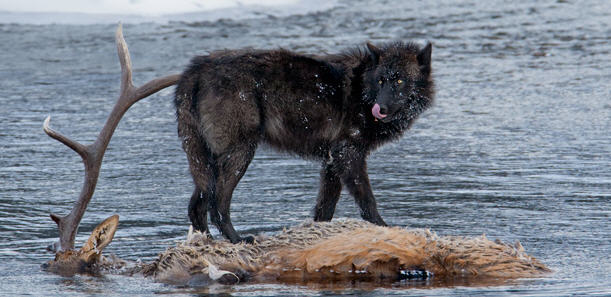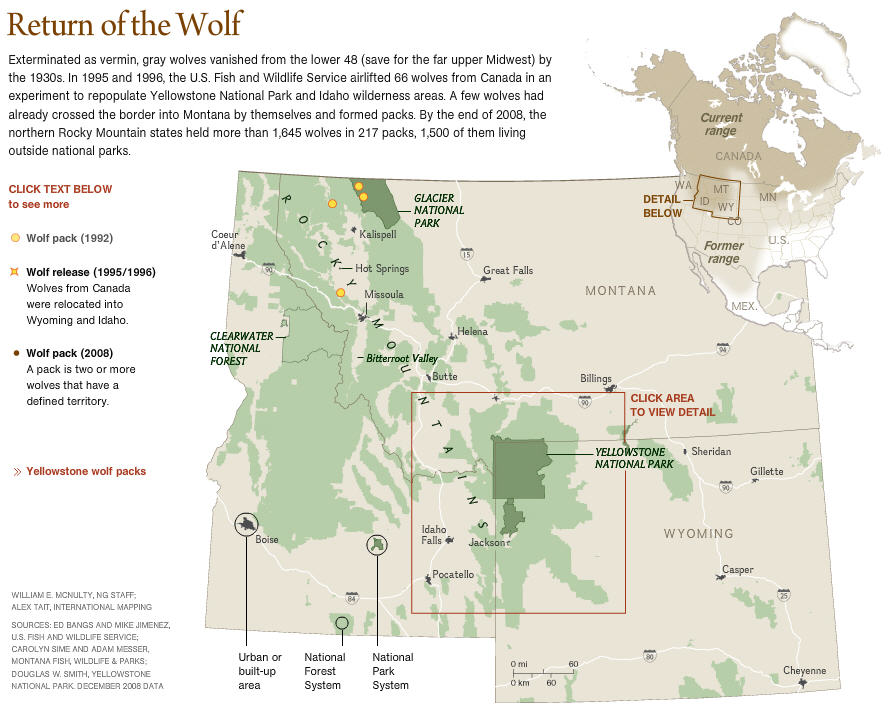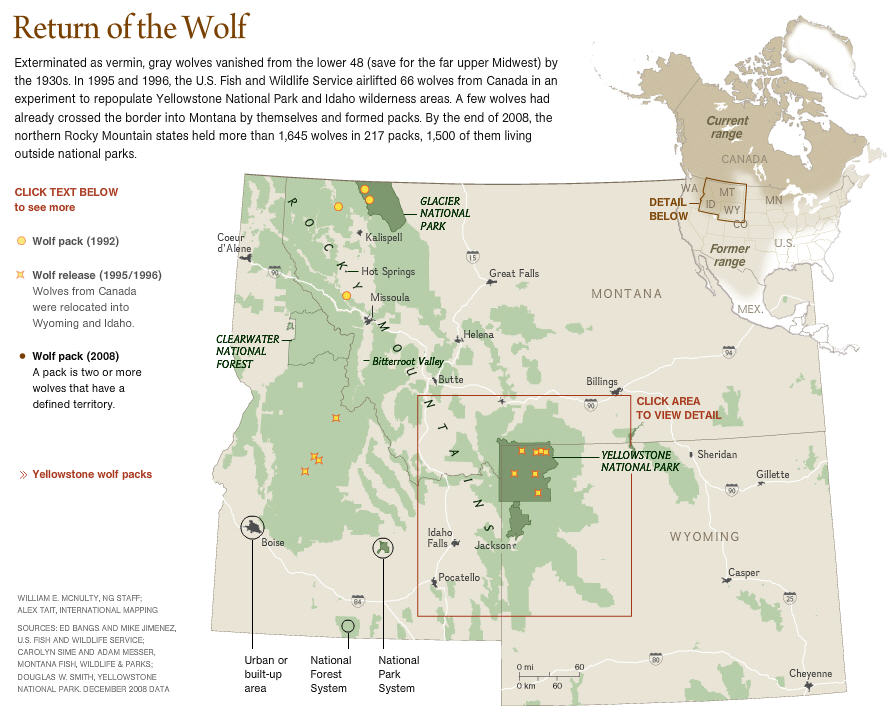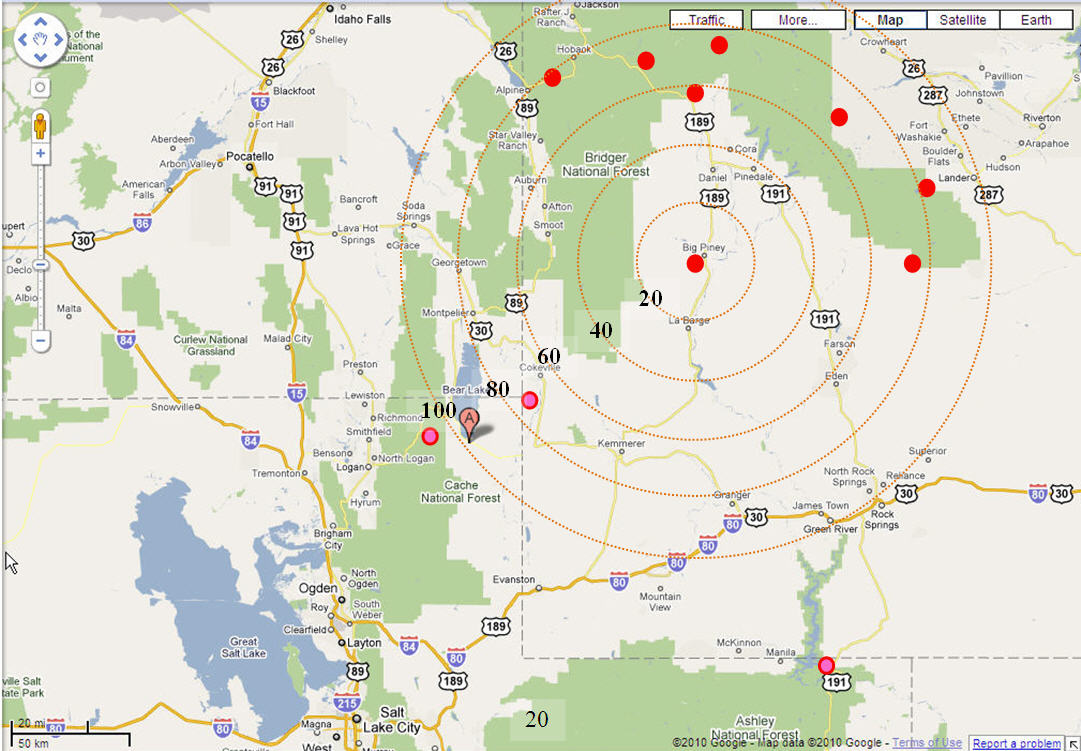National Geographic ran an article in the March issue titled “Wolf Wars.” It has a great interactive map. You’ll want to read the whole article, but I want you to look at something.
First, here’s a picture of a wolf in Yellowstone licking his or her chops over a recent elk kill. Looks real friendly, doesn’t it. Here, poochie, poochie, poochie.
A few facts. Wolves can grow up to six feet long (tip of nose to tip of tail) and three feet tall. They weigh on average about 80 pounds but can be as heavy as 150-190 pounds. Wolves can reach 40 mph when chasing, but the use their stamina more than speed. Regardless of how they catch you, their jaws are strong enough to crush bones. You want more facts? Go to this wiki article on canis lupis. The point is that they are large, smart predators. At the top of the food chain. These aren’t little doggies. They’re killers. And they are mighty hard to socialize with humans (read the wiki article).
Of course, it can be done. Not far away in Heber City, Utah lives Doug and Lynne Seus (yes, that’s the name–gotta love it!) who train wild animals for movies. The company is called Rocky Mountain Wasatch Wildlife. I know you’ve seen one of their animal “actors,” Bart the bear, in many movies. The Seuses also happen to train wolves. A friend of mine grew up in Heber with the daughter of Doug and Lynne. She visits from time to time. Last summer she went down and saw the wolves. My friend was told that she had to carry any children she might bring.
Why?
Because the children are food. That’s why. And when she went out there, the wolves were tracking those children every minute with their eyes. Freaked her out. In fact, another friend got so freaked she took her kid back to the main house and didn’t come out again. Folks, these are wolves that work with humans ALL THE TIME.
I know the nature programs often make it seem like wolves are harmless, but they’re predators. Just like grizzlies, tigers, or crocodiles. Wolves are dangerous. A pack kills up to two elk a week. That’s a lot of eating. But they’re all up in Yellowstone, right?
Um, no.
Exhibit 1: Documented wolf packs, i.e. two or more wolves, in 1992 (click on image to see it full size)
Exhibit 2: packs released in 1995
Exhibit 3: wolf packs as of 2008 (2 years ago)
Holy schnitzel!
If you didn’t read it above, they’re estimating about 1,645 wolves in 217 packs. And that’s just the ones that have been officially documented. You know there are more out there that haven’t been seen. Look at the one all the way out by Casper, WY. Those bad boys can travel. In fact, the NG article says that wolves stake out a territory of about 200 to 500 square miles (a circle of that size has a radius of 8 to 13 miles). They travel on average (AVERAGE!) 60 miles from their pack when seeking a mate or new pack. Although one was recorded traveling 500 miles.
Okay, so given the maps and sightings above, how is the John Brown family doing down in Laketown?
Exhibit 4: I need a gun!
The map below marks Laketown, UT with an A. I marked over that the packs shown in NG in red and others reported in pink. I also show orange rings 20 miles apart.
The “unofficial” sighting just inside the 80 mile ring was by my brother-in-law. The wolves were killing a bunch of his neighbor’s ewes he was taking care of. I didn’t say “eating” because they were killing far too many to eat. Wolves looked up at brother-in-law on four-wheeler. Assessed him. No whimpering, no cowering, no doggie wagging of tails. Just a frank assessment–human, danger or lunch? Said wolves sent a herd of the willies galloping up brother-in-law’s back. Freaked him out. He high-tailed it out of there and called the Feds who found that pack and killed them about fifteen miles away. But that sighting was before 2003. The sighting just outside the 100 mile mark was by some neighbors around 2007. The sighting down by Manila, UT was reported in a news report by KSL news in 2008, just two years ago.
Okay, so I think it’s pretty safe to say that we probably have wolves in our backyard. And if we don’t, they’ll be here in a year or three.
Go read “Wolf Wars” in the the National Geographic. It’s free. Then tell me how you’d feel with a few packs in your backyard. Are you all warm and comfy? Here, little doggie . . .
So I’m thinking that when the girls or I go hiking, which we do all the time, we need to carry more than a walking stick. More than a paintball gun used to scare the deer out of our garden. I know that even with all the packs shown above, I haven’t heard about wolves attacking humans, but is it wise to assume they just freak out when they see humans and all run away–“that’s a eight-year-old human girl, she will make me wear the cone of shame. I do not like the cone of shame.”
Or will it be, “Hum, possible lunch over there, let’s check it out. Ooh, look at the fat one. I bet he’s tasty.”
What do you think?




















I understand your concern, John, I really do. We have a growing coyote problem here in metro Atlanta – of all places. However, let’s not forget that wolves are considered endangered. The fact that they are making such a remarkable comeback is astonishing. Yes, we need to exercise do-diligence when we are living, working or recreating in areas that are deemed “wild”. I’m not saying that you shouldn’t go hiking with your daughters. What I am saying is that when we intrude into the wilderness, we *must* understand that there are consequences, some which are good and some that might be bad. We can’t reasonably expect the wilderness to conform to our expectations.
I doubt anyone wants zoos to be the only place wolves can live peaceably.
I don’t know. I think we make the wilderness conform to our expecations all the time–farms, dams, Atlanta suburbs.
But, like you, I am happy to give wolves places to run. And I don’t mind that they’re running outside of Yellowstone. I’m not a zoo-only guy. But it does alarm me. They’re not like bears or mountain lions. Altogether different from coyotes. In fact, we have three packs of coyotes within a few miles of our house and they don’t worry me a bit. We have mountain lions that come through our area. No issues. But a pack of wolves would concern me. And they should.
If I were in Africa out on the plains, I would take precautions to guard against lions or hyenas (those guys drag people out of their beds). And I would not hesitate to shoot if I felt endangered. I guess that’s the point of my post. For decades now the forests out here have been relatively tame. We have bear, but not in the numbers you get in Alaska, and they don’t hunt like wolves do. We have mountain lions. But they stay away. However, wolves have already come down close to humans and killed.
Part of me says that if the wolves run outside certain areas, they should be fair game to shoot. I don’t know if that area is Yellowstone or something larger. I think one of the reasons why wolves were eradicated while the coyotes weren’t is because the wolves didn’t adapt well to living close to humans. They were just too threatening to people and livestock. Their game is too large. Coyotes eat rabbits and smaller stuff. They don’t take down big things like adult elk and bison. And they don’t chase grizzlies off of kills. It will be interesting to see what happens this time around.
I suspect most Western states will follow Idaho’s and Montana’s leads and keep the population down by issuing hunting permits. Because, ultimately, there’s always a point where people do say enough is enough.
For me game management, especially big game management, is nothing more than ranching. It’s just that your range is huge. But it’s management nevertheless. So it’s cool they’re running wild. But it’s dangerous and I’m not for unlimited danger. I’m not one of these people who would like to see cheetas and African lions reintroduced as some want (they argue that the western US antelope could have only evolved its speed and stamina in response to a very fast threat–lions).